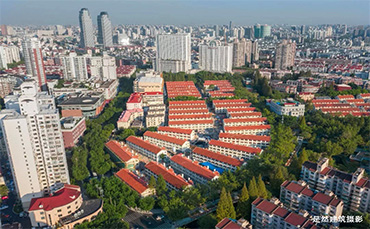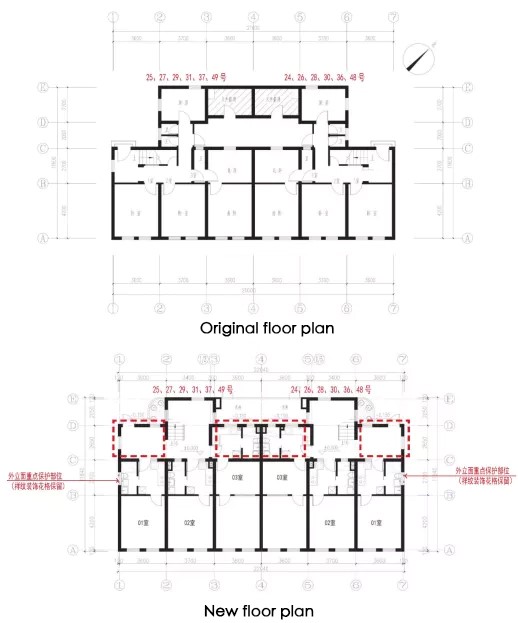


Caoyang, constructed in 1952, was China's first "new village for workers" - a residential community of matchbox apartment buildings designed by architects from the Soviet Union in the 1950s. Only those awarded honorary titles, such as "model laborer" and "advanced worker", were allowed to live in the apartments. The apartments were all equipped with tap water, lamp, gas and toilet.

Old photos of Caoyang residential community
As a residential area built during the planned economy period, Caoyang Village represents the beginning of the socialist Shanghai public housing system. Its construction process reflects the "four unifications" principle of the public housing system, that is "unified investment, unified construction, unified distribution, and unified management" by the government.
As the first large-scale residential area in China to be designed following the "neighborhood unit" concept, Caoyang New Village plans the overall scale of the community with a service radius of 600 meters from the community center, and allocates the public service facilities at three levels. All residents can easily access to the facilities for recreation, medical treatment and shopping within 10 minutes. It also planned with a pedestrian-friendly street network with small blocks. There is a ring-shaped river like a blue chain in the community, making Caoyang Village an ecological and beautiful living environment.

Master Plan of Caoyang New Village [Photo / by Wang Dingzeng]
In 2019, the government of Putuo District launched a program to renovate all old houses in this district, and Caoyang No.1 Village was included. Following the requirements of the municipal government on "protecting and retaining old buildings, and carefully renovating and demolishing", Caoyang Yicun, as an excellent historical building in Shanghai, adopts the renovation method of retaining the original houses and residents, improving the living conditions, while protecting the excellent historical buildings and inheriting the cultural heritage.

Photos of the renovated Caoyang No. 1 Village
More than ten experts from the Shanghai architectural community and the heads of management departments jointly put forward ideas and suggestions on the renovation process. The final project is: for the internal structure of each building, to provide each suite with a private bathroom and kitchen, the outer wall of north inner courtyard is expanded outward for 2.65 meters, to add about 4 sq. meters area to each suite. The exterior of houses is repaired to restore the original appearance. All the constructions are using the same materials and follow the original building process. The iconic red roof was re-constructed using clay flat tiles to restore the historical style. The south facade, as a key protective part of the historical buildings, has restored the window walls that were demolished before. All the windows have been transformed into to same style and color as the original but with modern materials-the Low-E windows. The decorative shape on the gable wall is preserved as well. The original timber-framed flat-tile canopy on the north facade of the building was all been recorded with numbers before the renovation and restored after the new building entrance was completed.

The green space of residential groups carries many memories of Caoyang residents. The designers add squares, gallery pavilions and some modern intelligent facilities, such as 5G artificial intelligence light poles, electronic screens, etc., which can provide smart lighting, environmental monitoring, broadcasting and other functions. The group green space is renovated to provide residents with a public space with their old memories and facilities for modern life. The original plants are preserved and new drying racks are added around the buildings. Designers also re-organized the traffic space in the community to make the public open space separate from the traffics. More parking lots and new energy vehicle charging piles are provided. For example, the parking lots in the one residential group have increased from 20 to more than 70. At the same time, all the overhead lines like "spider webs" in the air have moved under the ground. The original chaotic and old community environment has been completely renewed.

The floor plan of residential buildings in Caoyang Village
The indoor renovation of each suite is designed personally to meet the different needs of about 1500 households in Caoyang Village. "Some families want a big room in the suite; some residents have a large family and want more separated rooms." as Jin Xiaoming, a designer at Shanghai Architectural Decoration (Group) Design Co., Ltd., said, "We make all the needs of residents on the drawing, and do the renovations. "
This urban old community regeneration program aims to seek a balance between protecting excellent historical buildings and improving the living conditions of residents. After the renovation, the original spatial structure and building style of the red tile and white walls are all well preserved, and the old suites with shared kitchens and bathrooms have been changed into modern apartments. The old Caoyang Village walks to a new life step by step.
Source: <https://mp.weixin.qq.com/s/n4Ip5XaKnAUaGJ_5LCUC2g>
Translated by Jia Mengyuan